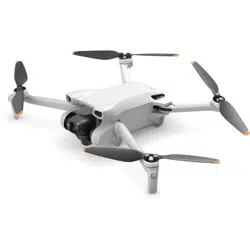Loading ...
Loading ...
Loading ...

12
©
2022 DJI All Rights Reserved.
Aircraft
DJI Mini 3 contains a flight controller, video downlink system, downward vision system, infrared
sensing system, propulsion system, and an Intelligent Flight Battery.
Flight Modes
DJI Mini 3 has three flight modes, plus a fourth flight mode that the aircraft switches to in certain
scenarios. Flight modes can be switched via the Flight Mode switch on the remote controller.
Normal Mode: The aircraft utilizes GNSS and the Downward Vision System and Infrared Sensing
System to locate itself and stabilize. When the GNSS signal is strong, the aircraft uses GNSS
to locate itself and stabilize. When the GNSS is weak but the lighting and other environmental
conditions are sufficient, it uses the Downward Vision System. When the lighting and other
environment conditions are sufficient, the maximum tilt angle is 25° and the maximum flight
speed is 10 m/s.
Sport Mode: In Sport mode, the aircraft uses GNSS and the Downward Vision System for
positioning. In Sport mode, aircraft responses are optimized for agility and speed making it
more responsive to control stick movements. The maximum flight speed reaches 16 m/s.
Cine Mode: Cine mode is based on Normal mode and the flight speed is limited, making the
aircraft more stable during shooting. The maximum flight speed is 6 m/s.
The aircraft automatically changes to Attitude (ATTI) mode when the Downward Vision System
is unavailable or disabled and when the GNSS signal is weak or the compass experiences
interference. In ATTI mode, the aircraft may be more easily affected by its surroundings.
Environmental factors such as wind can result in horizontal shifting. The Intelligent flight
modes or the Return to Home function cannot be used. The aircraft cannot position itself or
brake automatically, which increases the risk of potential flight hazards. To avoid changing to
ATTI mode, users should avoid flying in environments with poor GNSS signal or poor lighting
condition, and do not fly in confined spaces.
•
The maximum speed and braking distance of the aircraft significantly increase in Sport
mode. A minimum braking distance of 30 m is required in windless conditions
•
A minimum braking distance of 10 m is required in windless conditions while the
aircraft is ascending and descending in Sport mode or Normal mode.
•
The responsiveness of the aircraft significantly increases in Sport mode, which means
a small control stick movement on the remote controller translates into the aircraft
moving a large distance. Make sure to maintain adequate maneuvering space during
flight.
•
The flight speed and attitude are both restricted when the aircraft is flying leftward or
rightward to ensure shooting stability. The restriction reaches its maximum when the
tilt of the gimbal is -90°. If there are strong winds, the restriction will be disabled to
improve the wind resistance of the aircraft. As a result, the gimbal may vibrate while
shooting.
•
Users may experience a minor tremor in videos recorded in Sport mode.
Loading ...
Loading ...
Loading ...
